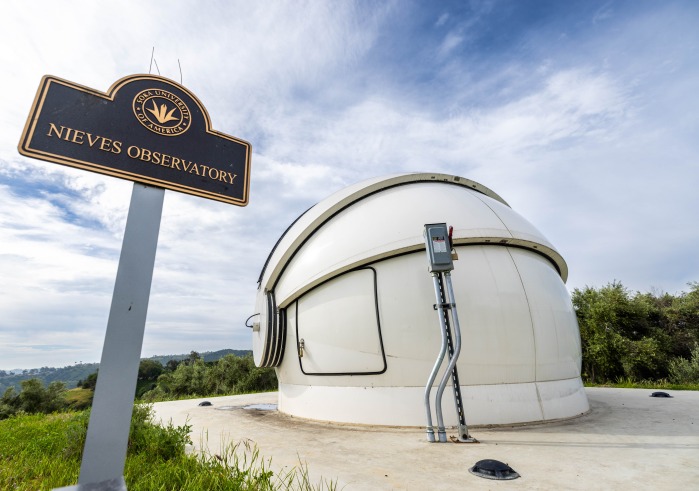From Earth to Infinity: SUA's Luis and Linda Nieves Observatory Pioneers New Frontiers in Education and Research

The Luis and Linda Nieves Observatory was unveiled at SUA in 2020, at a time when its remote accessibility proved essential. Amid the global lockdowns of the COVID-19 pandemic, which heightened feelings of isolation, students could still explore the vast reaches of space from their homes. Now, even with students back on campus, this innovative observatory continues to serve as a vital resource, enabling remote researchers from around the world to connect and collaborate without the need to cross international borders.
The Luis and Linda Nieves Observatory is just one of the most recent examples of pioneering work in education happening at SUA , made possible by generous donations from individuals who deeply believe in Soka’s mission and the potential for its students and faculty to achieve greatness.
Humanity’s fascination with galaxies beyond our own has long sparked existential questions about life, connection, purpose, and meaning. Our relationship with the stars has guided human beings as the first maps in darkness, and a vessel for making sense of overwhelming forces seemingly beyond human comprehension. Science has only further confirmed the essential relationship between life on earth and outer space.
The cutting-edge robotic telescope features an advanced system that can be operated from anywhere on the planet. The surrounding nature preserve provides expansive green space and thus a relatively dark sky, which is essential for good visibility. Thanks to its accessibility from around the world, the observatory is becoming a global hub for astronomers everywhere.
The observatory is run by Professor Bryan E. Penprase, vice president for sponsored research and external academic relations, and professor of physics and astronomy. Penprase, in his sixth year at SUA, has a rich academic and research history as a visiting scholar at Harvard University and founding faculty member and inaugural director of the Yale-NUS Centre for Teaching and Learning. In 2010 he authored The Power of Stars: How Celestial Observations Have Shaped Civilization (Springer).
“Astronomy instills our common humanity,” said Penprase, when discussing how the observatory embodies SUA’s mission to cultivate global citizenship. “Every person who’s ever lived will share the same sky.” In addition to being open to Penprase’s students, members of the astronomy club, and any student who would like to learn how to use it, the program supporting the observatory’s operation is also building relationships with Soka high schools and other institutions in the U.S. and around the world.
The observatory uses AI to help automate and streamline targeting, and the observatory’s website features a page where anyone can use the AI-powered target selector. There was a time when, in order to script a telescope, a person would need to input a command, wait, input another sequence of commands, wait, and so on. Now with AI, the customized chatGPT can suggest scripts and sequencing and also autonomously input code and sequencing.
In the almost four years the observatory has been up and running, it has contributed to scientific research and captured breathtaking images of space. “At this point we have been able to use the telescope to attempt to acquire data on an extrasolar planet system,” says Penprase, whose work on extrasolar planets using the observatory was published in The Astronomical Journal.
This data on an extrasolar planet system was also the subject of SUA student Daniel Navarrete-Toulet’s ’21 senior capstone. “The research in Daniel’s capstone and the published paper was part of our larger effort to develop the telescope as a useful facility for monitoring extrasolar planets, which I hope will be one of the research areas for the observatory in coming years,” said Penprase.
Astronomers at Penn State University have used the telescope remotely to study exoplanets and students from Caltech have used it to monitor comets and asteroids. Additional projects on the horizon include plans to study bright supernovae and other objects that require global collaboration among researchers.
Images of galaxies, nebulae, solar systems, and star clusters can be found on the observatory’s online gallery. One image, the Eagle Nebula, or M 17, was taken in 2021 over the course of many weeks, approximately 7,000 light years away. The center of the nebula showcases a cluster of famous clouds known as “the Pillars of Creation,” one of the most well-known images from the Hubble Space Telescope. “We are so grateful to the Nieves family for making this important work possible,” said Penprase.
“SUA is like the dawning sun, the brilliant orb that heralds a new day,” said acclaimed Brazilian astronomer Dr. Ronaldo Rogério de Freitas Mourão. “It will stand as a new beacon of light and hope for education, an institution that unites and integrates knowledge, wisdom and compassion for the betterment of humanity.”
SUA founder Daisaku Ikeda recounted Mourão’s observation during their dialogue in his message to the undergraduate class of 2009’s commencement ceremony. That year also happened to be the International Year of Astronomy, named by the United Nations in commemoration of the 400th anniversary of Galileo Galilei’s invention of the telescope.
The research and discoveries conducted at the Luis and Linda Nieves Observatory will provide immense contributions to our global understanding both of the universe and ourselves. “Imagine the limitless promise the future holds for each of you, the multitude of paths that you shall discover and spearhead, or broaden anew. Granted, the real world can be cruel and unrelenting,” Ikeda shared in the same commencement ceremony message when reflecting on the 400th anniversary of the invention of the telescope. “The power to triumph over any difficulty, remember, lies within.”
A 360-degree image of the observatory’s interior is available online.
